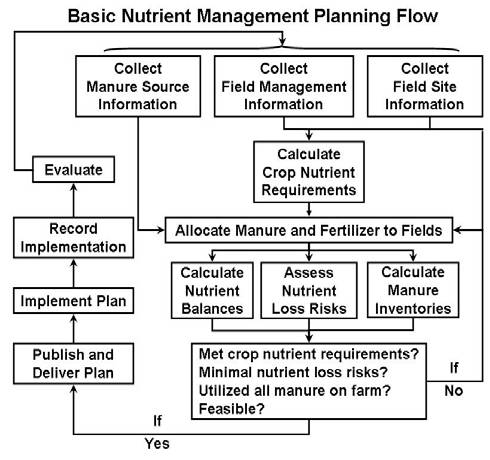Competency Area 6: Nutrient Management and Planning
PO 53. Describe the importance of the following steps of an economically- and environmentally-sound nutrient management plan.
- Locate facilities and fields on maps
- Identify environmentally-sensitive areas, including wells
- Specify crop rotation
- Determine expected yields
- Obtain results of soil, plant, and water analyses
- Quantify nutrients from all sources available to the farm
- Develop a nutrient budget for each field
- Make recommendations of nutrient rate, timing, form, and method of application
- Review and modify the plan as needed
Locating facilities and fields on maps enhances communication between the planner, producer, farm staff, and custom applicators.
Identifying environmentally-sensitive areas allows for careful management of nutrients to minimize offsite environmental impacts.
The crop rotation drives fertility guidelines, especially N.
Expected yields drive fertility guidelines, especially N, and help with overall assessment of forage production.
Soil tests drive P, K, Mg, etc. guidelines and manure application rates. Plant analyses help determine the nutrient removal of plants, and can assist in diagnoses of plant nutrient status. Water analyses determine the level of nutrients in the water, which can indicate potential excesses (i.e. losses) in existence.
Quantifying nutrients from all sources available assists in the proper allocation of them across the farm, and informs the user whether export of manure nutrients is needed. Nutrient sources include manure, compost, biosolids, fertilizer, legume N, residual manure N, etc.
A field-specific nutrient budget is the amount of each nutrient required for optimum yield. Estimates of nutrient additions from all sources and nutrient losses are made, and then nutrient additions are adjusted to meet crop needs and to not exceed other environmental goals.
Recommendations of nutrient rate, timing, form, and method of application should be made, keeping in mind how they affect nutrient availability and risk of environmental loss. This step includes identification of periods of excess water where runoff, erosion, and leaching may occur. Nutrient applications should be avoided during these times.
Review and modify the plan as needed, at least annually. These updates are needed to reflect actual application rates, timing, method, rotation shifts, purchase of new land, and other changes that could impact management in the next year.

Quick Links
- Competency Area 1: Basic Concepts of Plant Nutrition
- Competency Area 2: Basic Concepts of Soil Fertility
- Competency Area 3: Soil Testing and Plant Tissue Analysis
- Competency Area 4: Nutrient Sources, Analyses, Application Methods
- Competency Area 5: Soil pH and Liming
- Competency Area 6: Nutrient Management and Planning
